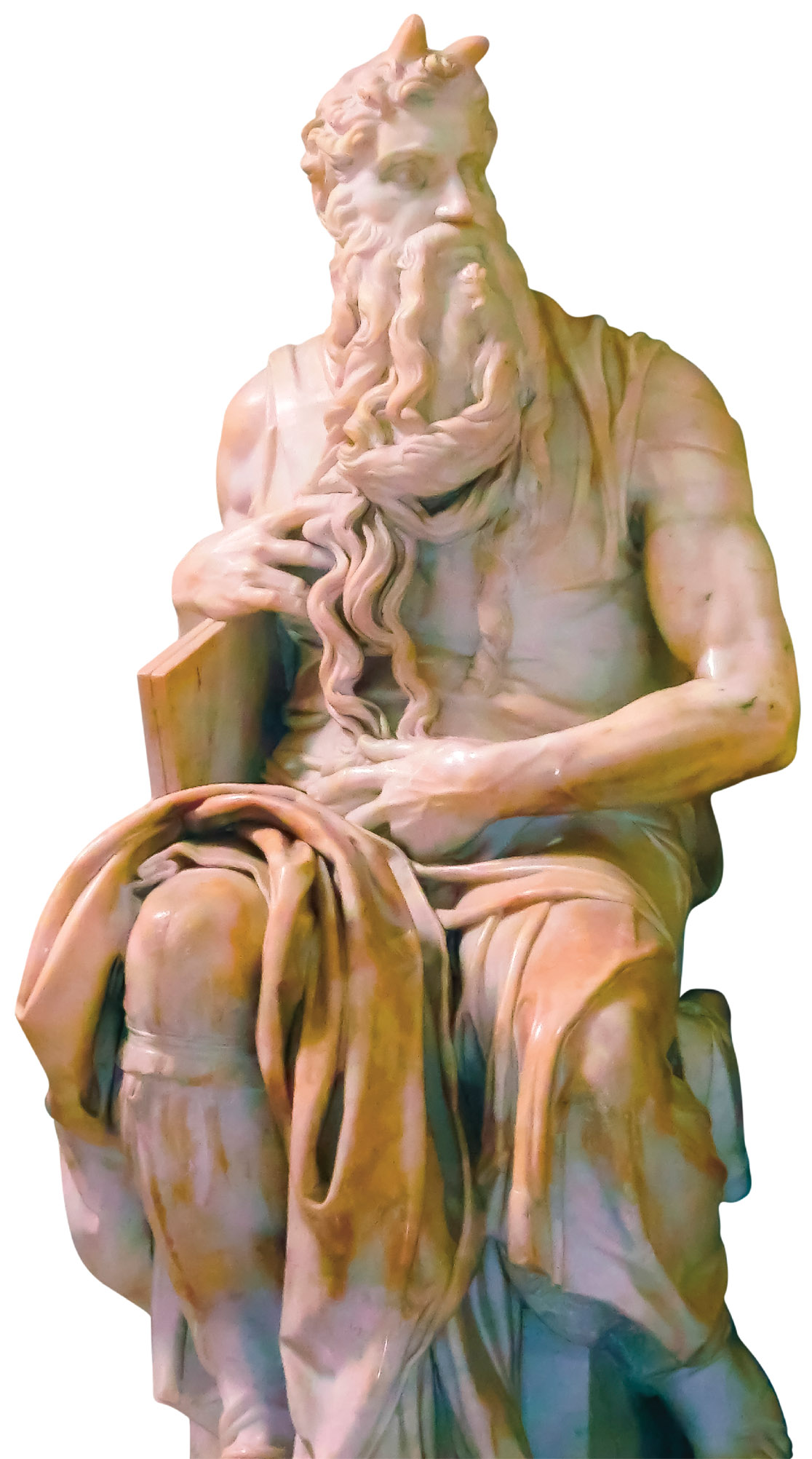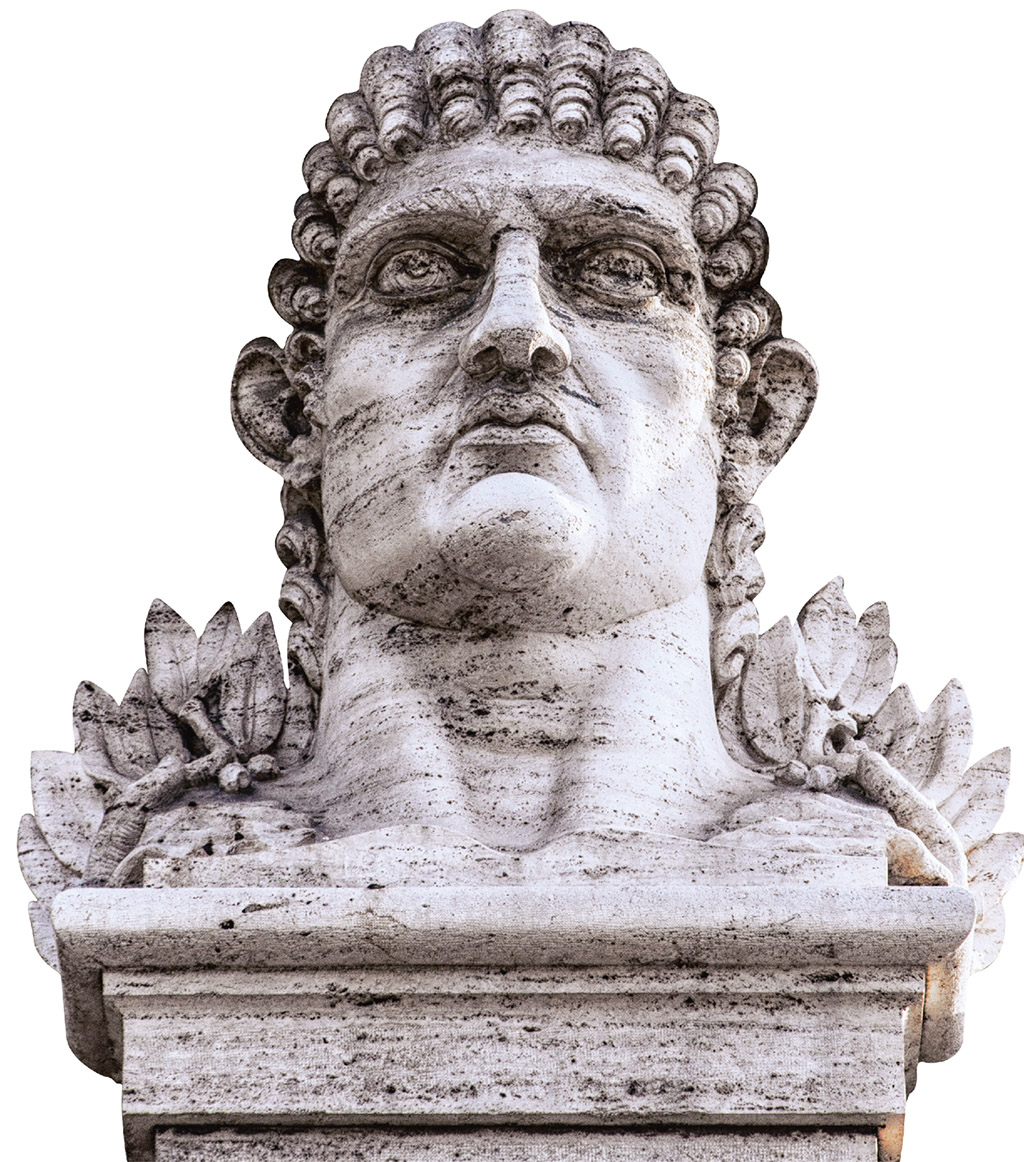
t Interior of Santa Pudenziana showing the splendid 4th-century apse mosaic
Churches tend to be dedicated to existing saints, but this church, through a linguistic accident, created a brand new saint. In the 1st century AD a Roman senator called Pudens lived here, and is said to have allowed St Peter to lodge with him. In the 2nd century a bath house was built on this site and in the 4th century a church was established inside the baths, known as the Ecclesia Pudentiana (the church of Pudens). In time it was assumed that “Pudentiana” was a woman’s name and a life was created for her – she became the sister of Prassede and was credited with caring for Christian victims of persecution. In 1969 both saints were declared invalid.
The 19th-century façade of the church retains an 11th-century frieze depicting both Prassede and Pudenziana. The apse has a remarkable 4th-century mosaic influenced by Classical pagan art.

t Interior of Santa Pudenziana showing the splendid 4th-century apse mosaic
Christians have worshipped on the site of this church since the 3rd century, when they used to meet in the house of a man named Equitius. In the 4th century, after Constantine had legalized Christianity, Pope Sylvester I built a church, one of the very few things he did during his pontificate. In fact he was so insignificant that in the 5th century a more exciting life was fabricated for him – which included tales of him converting Constantine and curing him of leprosy.
Pope Sylvester’s church was replaced in about AD 500 by St Symmachus, rebuilt in the 9th century and then transformed completely in the 1630s. The only immediate signs of its age are the ancient Corinthian columns dividing the nave and aisles. The most interesting interior features are a series of frescoed landscapes of the countryside around Rome (campagna romana) by the 17th-century French artist Gaspare Dughet, Poussin’s brother-in-law, in the right aisle.
Squashed between two buildings just off Via Carlo Alberto is the central arch of an originally three-arched gate erected in memory of Emperor Gallienus, who was assassinated by his Illyrian officers in AD 262. It was built on the site of the old Esquiline Gate in the Servian Wall, parts of which are visible nearby.
The horns on Michelangelo’s Moses’ head should be beams of light, but the Old Testament text was mistranslated.
Experience Esquiline
|
eat Trattoria Monti This cosy, ever-popular neighbourhood trattoria specializes in the cuisine of the Marche region, with hearty pasta dishes and superb beef, lamb and rabbit mains. It’s on the small side and hugely popular, so booking is essential. L6 ⌂ Via di San Vito 13 § 06-446 6573 ¡¡¡ Palazzo del Freddo di Giovanni Fassi This time-warp gelateria is worth visiting for its 1950s ice-cream parlour decor alone – and the gelato’s not bad either, with all the classics, as well as more unusual flavours such as rose and cardamom. M6 ⌂ Via Principe Eugenio 65 ∑ gelateriafassi.com |

t Michelangelo’s Moses in San Pietro in Vincoli
According to tradition, the two chains (vincoli) used to shackle St Peter while he was being held in the depths of the Mamertine Prison were subsequently taken to Constantinople. In the 5th century, Empress Eudoxia deposited one in a church there and sent the other to her daughter Eudoxia in Rome. She in turn gave hers to Pope Leo I, who had this church built to house it. Some years later the second chain was brought to Rome, where it linked miraculously with its partner.
The chains are still here, displayed below the high altar, but the church is now best known for Michelangelo’s Tomb of Pope Julius II. When it was commissioned in 1505, Michelangelo spent eight months searching for perfect blocks of marble at Carrara in Tuscany, but Pope Julius became more interested in the building of a new St Peter’s and the project was laid aside. After the pope’s death in 1513, Michelangelo resumed work on the tomb, but had only finished the statues of Moses and The Dying Slaves when Pope Paul III persuaded him to start work on the Sistine Chapel’s Last Judgment. Michelangelo had planned a vast monument with over 40 statues, but the tomb that was built – mainly by his pupils – is simply a façade with six niches for statues. The Dying Slaves are in Paris and Florence, but the tremendous bearded Moses is here, nearly 2.5 m (8 feet )in height, with his huge muscular arms and intense expression.
The church was founded by Pope Paschal I in the 9th century, on the site of a 2nd-century oratory. Although the interior has been altered and rebuilt, the structure of the 9th-century church is visible. Its three aisles are separated by rows of granite columns. In the central nave, there is a round stone slab covering the well where, according to legend, Santa Prassede is said to have buried the remains of 2,000 martyrs.
Artists from Byzantium decorated the church with glittering, jewel-coloured mosaics. Those in the apse and choir depict stylized white-robed elders, the haloed elect looking down from the gold and blue walls of heaven, spindly legged lambs, feather-mop palm trees and bright-red poppies.
In the apse, Santa Prassede and Santa Pudenziana stand on either side of Christ, with the fatherly arms of St Paul and St Peter on their shoulders. Beautiful mosaics of saints, the Virgin and Christ, and the Apostles also cover the walls and vault of the Chapel of St Zeno, built as a mausoleum for Pope Paschal’s mother, Theodora. Part of a column brought back from Jerusalem, allegedly the one to which Christ was bound and flogged, also stands here.

t A bust of Emperor Nero at the park entrance to the Domus Aurea
After allegedly setting fire to Rome in AD 64, Nero decided to build himself an outrageous new palace. The Domus Aurea (sometimes called Nero’s Golden House) occupied part of the Palatine and most of the Celian and Esquiline hills – an area approximately 25 times the size of the Colosseum. The vestibule on the Palatine side of the complex contained a colossal gilded statue of Nero. There was an artificial lake, with gardens and woods where imported wild beasts were allowed to roam free. According to Suetonius in his Life of Nero, the Domus Aurea’s walls were adorned with gold and mother-of-pearl, rooms had ceilings that showered guests with flowers or perfumes, the dining hall rotated and the baths were fed with both sulphurous water and sea water.
Tacitus described Nero’s debauched garden parties, with banquets served on barges and lakeside brothels serviced by aristocratic women. Since Nero killed himself in AD 68, however, he did not have long to enjoy his new home.
Nero’s successors, anxious to distance themselves from the monster-emperor, did their utmost to erase all traces of the palace. Vespasian drained the lake and built the Colosseum in its place, Titus and Trajan each erected a complex of baths over the palace, and Hadrian placed the Temple of Venus and Rome over the vestibule.
Rooms from one wing of the palace have survived, buried beneath the ruins of the Baths of Trajan on the Oppian Hill. Excavations have revealed large frescoes and mosaics that are thought to be a panorama of Rome from a bird’s-eye perspective.
Visitors are advised to bring a jacket as the temperature inside the building is around 10° C (50° F).
The deceptively simple façade of Santa Bibiana was Bernini’s first foray into architecture. It is a clean, economic design with superimposed pilasters and deeply shadowed archways. The church itself was built on the site of the palace belonging to Bibiana’s family. This is where the saint was buried after being flogged to death with leaded cords during the brief persecution of the Christians in the reign of Julian the Apostate (361–3). Just inside the church is a small column against which Bibiana is said to have been whipped. Her remains, along with those of her mother Dafrosa and her sister Demetria, who also suffered martyrdom, are preserved in an alabaster urn below the altar.
In a niche above the altar stands a statue of Santa Bibiana by Bernini – the first fully clothed figure he ever sculpted. He depicts her standing beside a column, holding the cords with which she was whipped, apparently on the verge of a deadly swoon.

t The Porta Magica in Piazza Vittorio Emanuele II
Rome’s largest square, Piazza Vittorio, as it is called for short, was once one of the city’s main open-air food markets. The market moved around the corner to covered premises in 2001 and is now called Nuovo Mercato Esquilino. The arcaded square was built as part of the urban development that was undertaken following the unification of Italy in 1861. It was named after Italy’s first king, but there is nothing regal about its appearance today. The garden area in the centre of the square contains a number of mysterious ruins, including a large mound, part of a Roman fountain from the 3rd century AD and the Porta Magica, a curious 17th-century doorway inscribed with alchemical signs and formulae, which belonged to a marquis whose home was often visited by alchemists and magicians.
Maecenas, a fop, gourmet and patron of the arts, was also an astute adviser and colleague of the Emperor Augustus. Fabulously rich, he created a fantastic villa and gardens on the Esquiline Hill, most of which have long disappeared beneath the modern city. The partially reconstructed auditorium, isolated on a traffic island, is all that remains.
Inside, a semicircle of tiered seats suggests that it may have been a place for readings and performances. If it was, then Maecenas would have been entertained here by his protégés, the lyric poet Horace and Virgil, author of the Aeneid, reading their latest works. However, water ducts have also been discovered and it may well have been a nympheum – a kind of summerhouse – with fountains. Traces of frescoes remain on the walls: you can make out garden scenes and a procession of miniature figures.
Not far from Nero’s Domus Aurea is the cistern of the Sette Sale, built here to supply the enormous quantities of water needed for the Baths of Trajan. These were built for Emperor Trajan in AD 104 on parts of the Domus Aurea that had been damaged by a fire.
A set of stairs leads down into the cistern, well below street level. There is not much to see here now, but you can walk through the huge, echoing cistern where light rays illuminate the watery surfaces. The nine sections, 30 m (98 ft) long and 5 m (16 ft) wide, had a capacity of eight million litres.